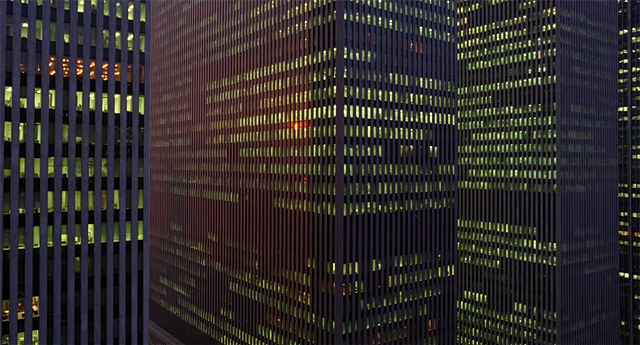 Base Emotions
Base Emotions
The Advent of Muzak Part 1
published in The Wire No.172, June, 1998, LondonEmotion. Many write about it. More hide it. Most defer to music as the retainer of its uncontainable fluidity, its propensity to spill over and engulf us. When one becomes conscious of emotional transcendence while hearing music, one is experiencing a dimensional transformation: one's sense of space is redefined, realigned, reconfigured. To listen is to float, sink, swim; to rise, soar, plummet. The primary erotic condition of music in this sense is to massage one with sensory trajectories: feelings of dynamic momentum which induce a giddyness of inexplicable power.
Musical patrons of conflicting persuasions invariably accept this prime musical effect. Equally undeniable is the apparatus which has most aplty and consistently generated the effect - the orchestra - though for vastly complex reasons. I'll summarize some of them. Firstly, the sense of music 'moving' one is figurative: it suggests a conflation of the geographical with the mystical, conjuring up an illusion of music's power to shift the earth and you with it. Monumentalism is required for this effect, and the grandiose, majestrial narratives which have attracted orchestral composers for over four centuries exploit this obsessively. Secondly, the sonic texture of orchestral music is multiple: its density witholds the power to abstract any individual instrument's identity into an amporphorous energy mass through combinations with its own kind and other's. Through this 'thickening' of instrumentality, the orchestra becomes a machine of controlled noise - a generator of multiplied and overloaded energies while articulating singular melodiousness. Thirdly, the orchestra is organized by matrix principles: its hive of busy bees allow for a near infinite mapping of vertical (pitch/frequency) and horizontal (harmony/timbre) variables. The aural analogue of the printer's benday dot screen, every moment of 'orchestrality' is a marker of degree - of how high, how low, with what and against what. With frightening precision, harmony is continually expressed and excreted, trapping us in its interlocking grid like targeted listeners.
In short, orchestras are big and loud; their gesthalt effect mystifies all means of production; and they use harmonic linguistics to precisely control and sway the listener. All this without resorting to either literature or locution. No wonder people are so consistently swayed by orchestral power; small wonder they are seduced into feeling 'moved'. Smallest wonder that film music typifies the most ruthlessly programmatic exploitation of the orchestral power. In the hands of most producer/director/composer triumverates, the result is narrowed, gnarled, inflated. Exceptions exist.
In Peter Weir's FEARLESS (1993), Jeff Bridges perches atop building ledges and rooftop bannisters, calmly rooted at the brink of the urban abyss below him. Having miraculously survived an airplane crash, he feels reborn, gifted, lucky, euphoric, alive. Throughout FEARLESS, Jeff Bridges' body hovers as if in defiance of gravity. He strikes a portrait of feeling - of someone caught in the act of feeling - as a metaphor for the act of listening, of being emotionally transcended through that act. Like the wind that seemes to pivot him on invisible ground not of our world, the soundtrack cross-fades airborne fragments of Penderecki's "Polymorphia" (the famous atonal passages of string sliding employed in THE EXORCIST and THE SHINING) and H. Gorecki's "Symphony No.3" (the renowned best-selling "Symphony Of Sorrowful Songs").
Penderecki and Gorecki? While most films desperately clarify their emotional tone through the blunt repetition of happy/sad dichotomies, FEARLESS is remarkable in cancelling the differences between tonality and atonality by using such radically opposed musical compositions in the name of a humanist celebration of life. The film is not schizophrenic in either content or form, and has little concern for any postmodern dissolution of meaning or erasure of grand narrative. Nor is it a co-option of avantgarde rigour in the name of Romantic aestheticism. Yet through its employment of music as both marker and retainer of its propellant emotionalism, FEARLESS manages to supplant the transcendental experience of music as a metaphor for feeling alive. Gathered under such a unified use of the orchestra, one can hear the surging postivity which billows out from the collapsed debris of "Polymorphia", just as one can hear the lachrymose negativity which drips upwards in the blurred beautification of "Symphony No.3". In effect, "Polymorphia" and "Symphony No.3" version each other, complementing their contradictory guises as facets of a larger orchestral totality.
Of course, it is Gorecki whom Weir leaves standing atop the tallest peak, but the cinematic realization of this tonal resolution constitutes an astute and breathaking narrative coup. Having been continually denied witness to the horror crash Bridges lived through, we are finally granted the visuals of the plane's last eternal moments. Gorecki wells up as we near this end passage of the film. Once the flashback commences, all synchronous sound disappears (this despite the fact that the most elaborate and extensive foley post-production was recorded and pre-mixed for the whole sequence, only to be discarded at the final mix). Now left with only Gorecki's rising sighs of strings, it is as if the plane floats not on air, but music, ready to join the angels with whom its engines consonate. This ethereal dimension is the same in which Bridges lives for the bulk of the film; it is the sound of music which has played in his head, alllowed him to defy gravity, and move us through its emotionalism. The scene concludes and fades to black, with Gorecki's cyclical strings sailing ever upward with the scrolling credits.
The primary erotic effect of Gorecki's "Symphony No.3" is that endless skyward spiral. To some degree, it is strangely gross in its supply of its beauty, the obviousness of which may account for its popularity. Nonetheless, its tactic of harmonic suspension is distinctive, and a cunning twist on the pleasurable oppressiveness of minimalism (more on that shortly). Watching Jeff Bridges and hearing this effect resonates strongly with John Carpenter's STARMAN (1985), staring Jeff Bridges as an alien, and featuring a score by Jack Nitzsche. STARMAN is less an action film typical of Carpenter, and more a love story with a deeply emotional relationship at its core: alien Jeff Bridges assumes the form of Karen Allen's recently deceased husband. As she helps the alien, she has to continually control her yearning for a lost one and suppress the need to connect with his genetic copy in the form of Bridges. Nitzsche pulls off another of his quirky compostional coups by simulating the synthetic minimalism of Carpenter while infusing it with a pseudo-orchestral thickness which does not shy away from the film's emotional drive. But instead of producing, say, a surfeit of emotionalist cliche (good examples: John Barry's DANCES WITH WOLVES, 1990; James Newton Howard's PRINCE OF TIDES, 1991; Jerry Goldsmith's POWDER, 1995; etc.), Nitzsche deftly balances the unreality of its love interest (Bridges isn't even human) with an unreal-sounding orchestral texture, that of a thousand and one string synthesizers.
The central motif for the film's entirety is a reverse cadence: two chords which rise upward only to fall back, only to rise up again. The end scene takes place in a huge crater in the middle of a desert which is the site for the aliens to retrieve the alien-Bridges. Karen Allen clutches him tightly as they hover in a dimensionally warped space deep inside the crater. Light is unworldly, gravity is reversed. They passionatley embrace, consumed by emotion, all the while knowing the profound depth of their unrequitable love. Again, another portrait is struck of beings trapped elsewhere, lost in the music, swirling in sound, pictured in a heightened state of listening, as the film score engulfs them and us.
STARMAN's ability to achieve this complex dialogue between orchestral density and orogenous degravitization has been all but ignored by cinema history. Two films better known for achieving a complementary effect are Godfrey Reggio's KOYAANISQATSI (1983) and POWAQQATSI (1988). The bodies and beings strewn like visceral architecture throughout both films elicit a different emotional response the suspended Bridges: less symbols of the transcendental act of listening, they are deaf to the power of music which trumpets around them. As innocent beings snared by the forces of "life out of balance", these people (not actors) neither react to it nor sympathsize with the music in which they apear to sink. Philip Glass' minimalist quagmire is a deliberately excessive concotion of boom, gloom and doom. It plays with deafening density, like an orchestral machine whose every control is set to full energy level and incapable of being turned off. Far from experiencing the luxury of transcendnce, the films' oppressed denziens of exploited cultures are coloured with a helplessness courtesy of Glass' music which casts them out of balance with the film score.
This harsh and uncompromising approach to scoring has received little critical investigation. Many are understandably overwhelmed by the powerfully emotional images in KOYAANISQATSI and POWAQQATSI, but few realize Glass' tactic of contra-scoring. No slight tinkling of fey melodies to suggest the frailty of human life here. In place, we have dread-inducing collisions between a screaming chorus of heavenly angels, a massive ground swell of subterranean crypt organs, and enough strings to decimate the world's cat population by half. Patrons leave the cinema shell-shocked by the music, blasted as much by its incessence as its volume. More than another tasteful tailoring of minimalist style, here is the orchestra as a postmodern inversion of machinic excess: its majesty and beauty is hyper-referenced in such full-effect that it erodes at its own foundations. Glass' scores to Reggio's films picture yet another site of dimensional restructuring. Like the reformed desert crater of STARMAN and the blindness to gravity at building edges in FEARLESS, the Reggio films abound with similarly reconfigured zones which superbly imagine that most elusive state of transcendent state: listening to music.
Text © Philip Brophy 1998. Images © respective copyright holders




